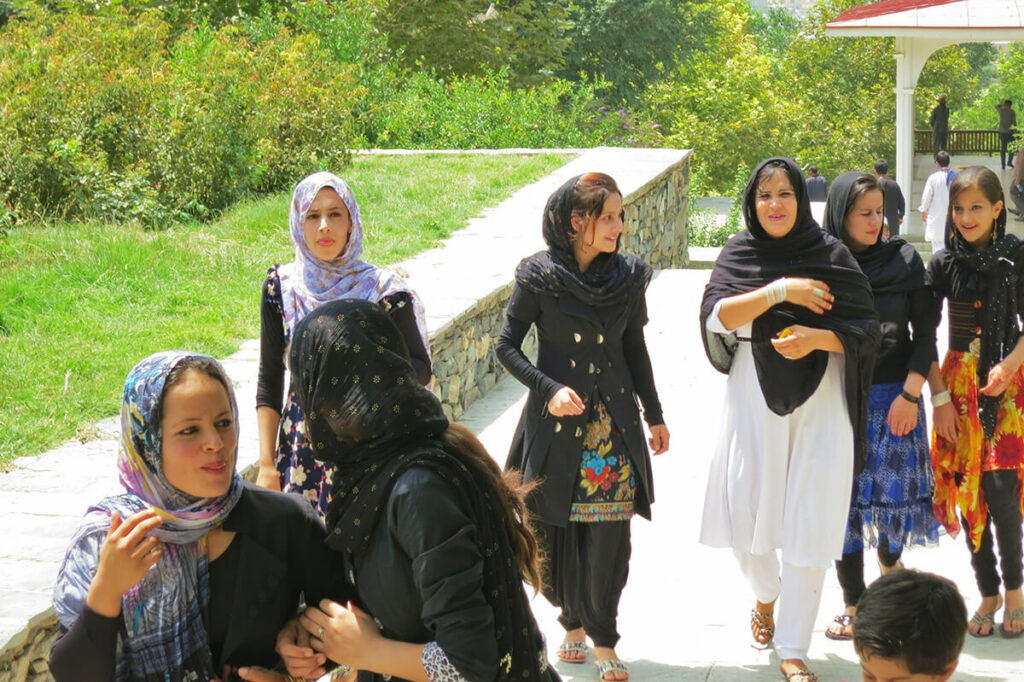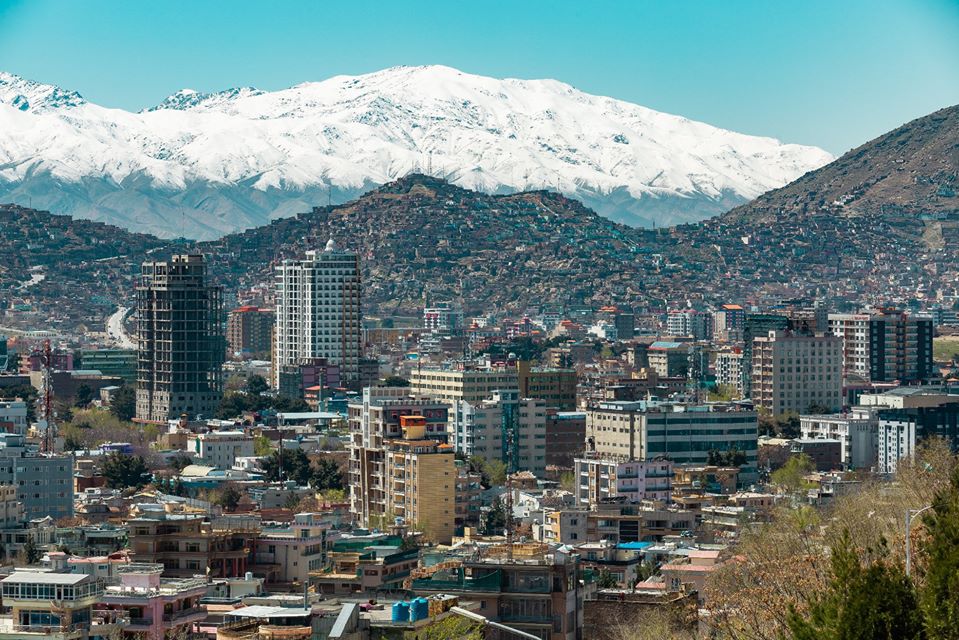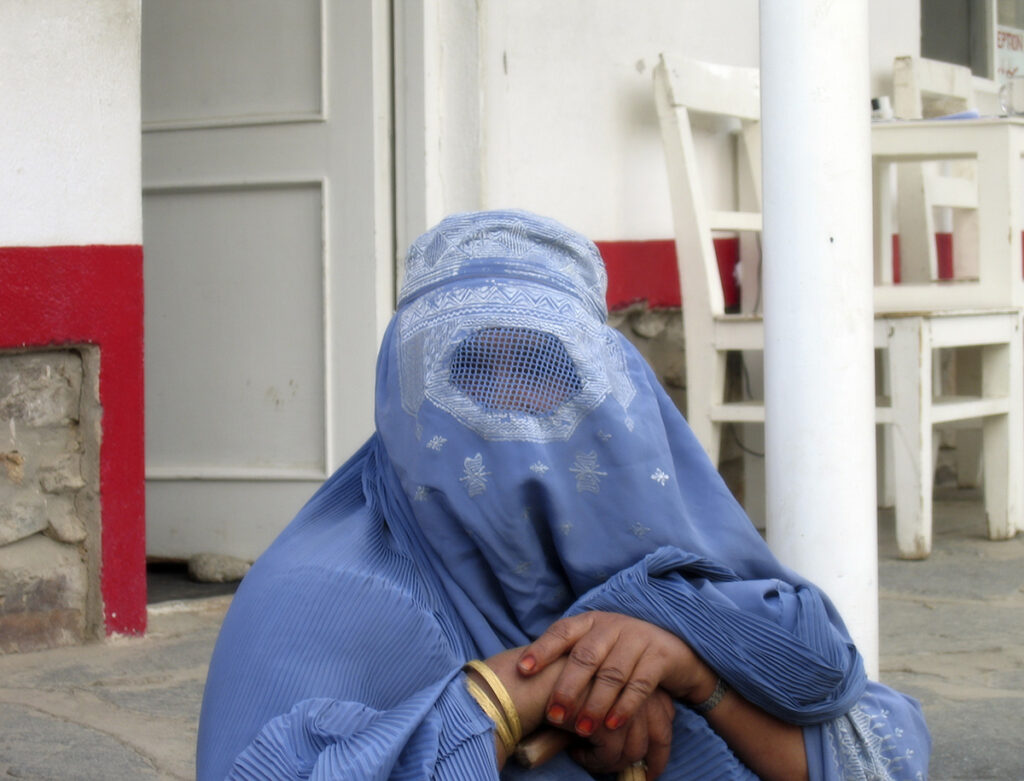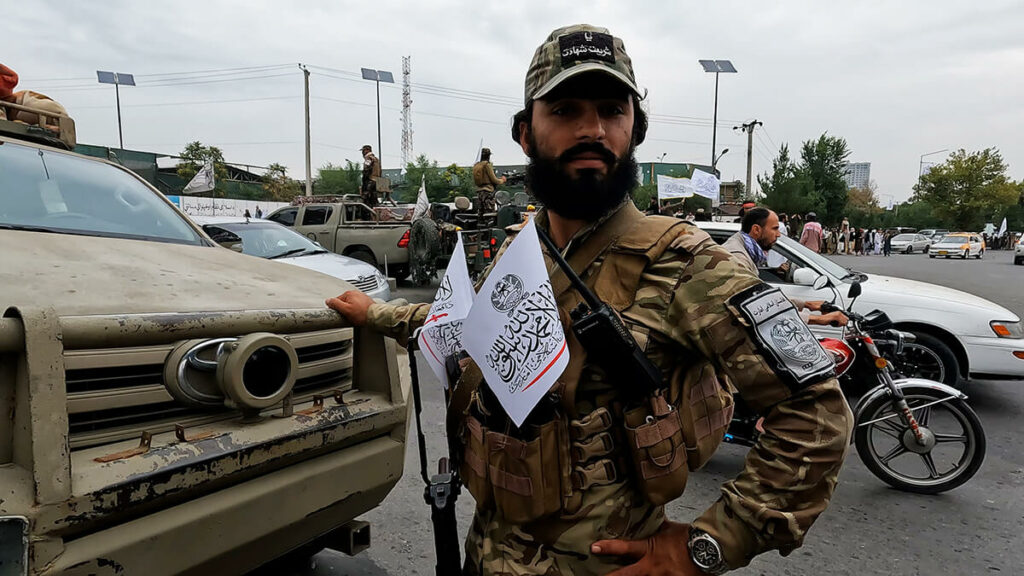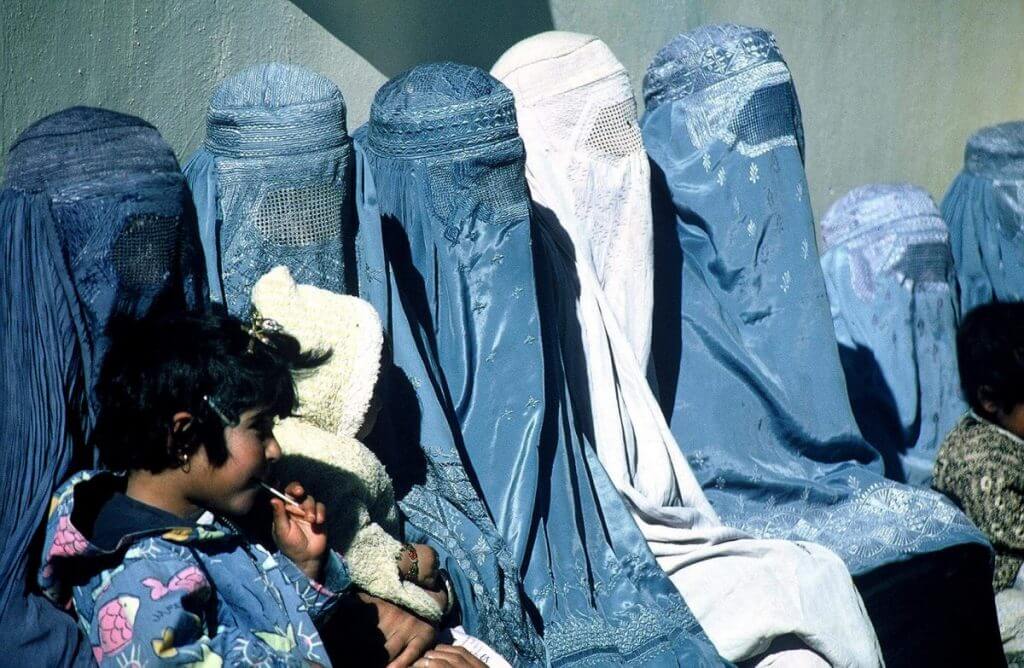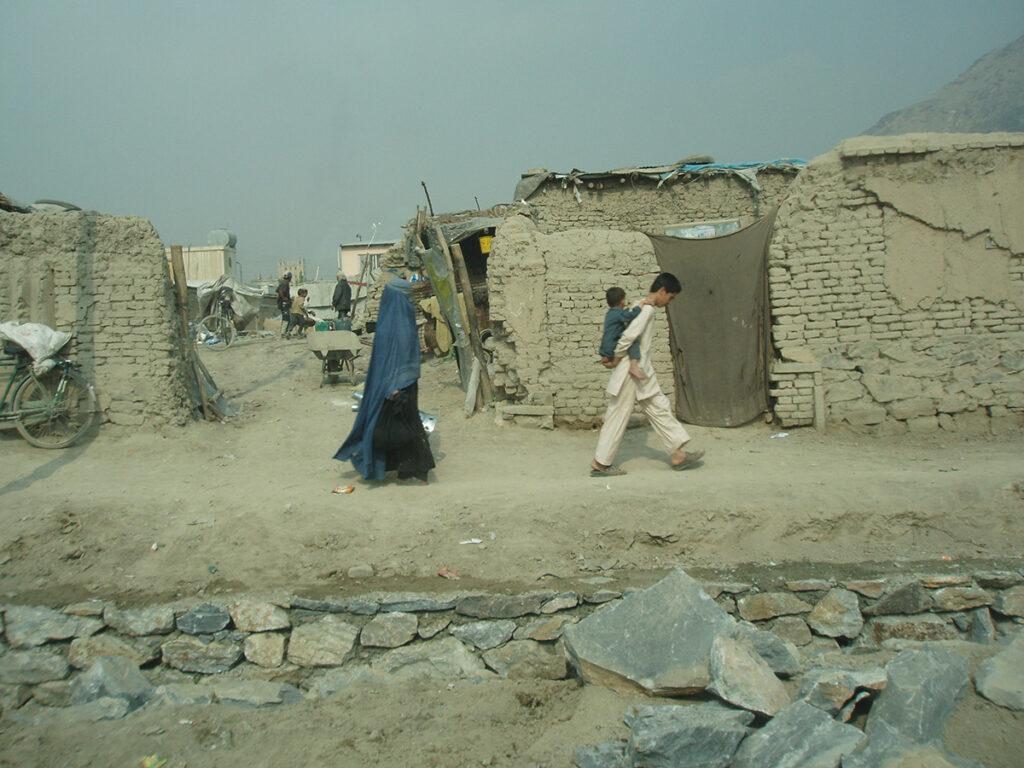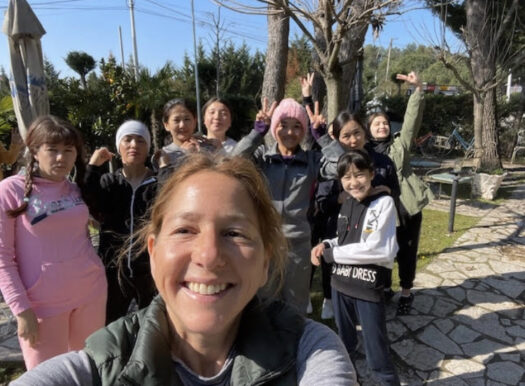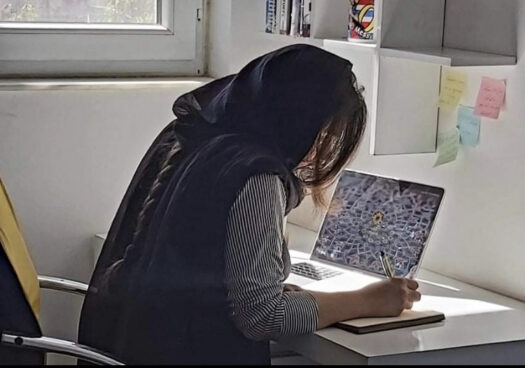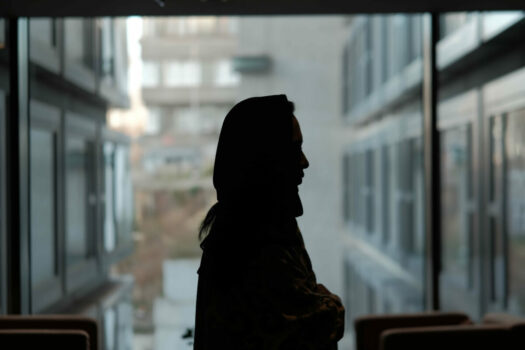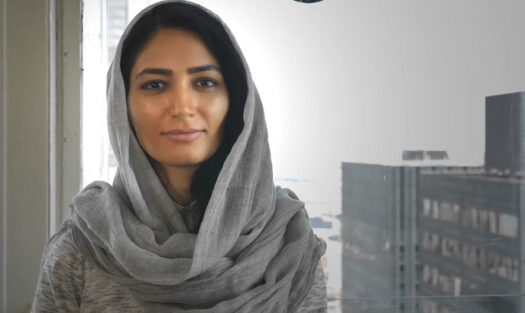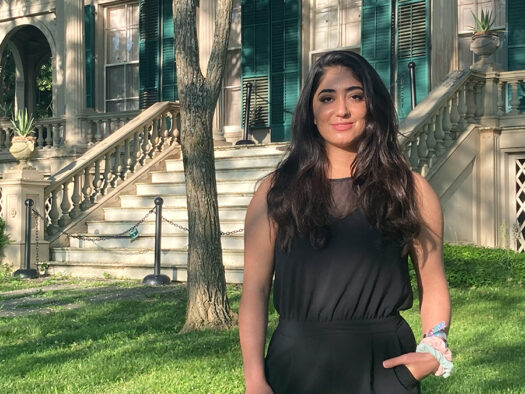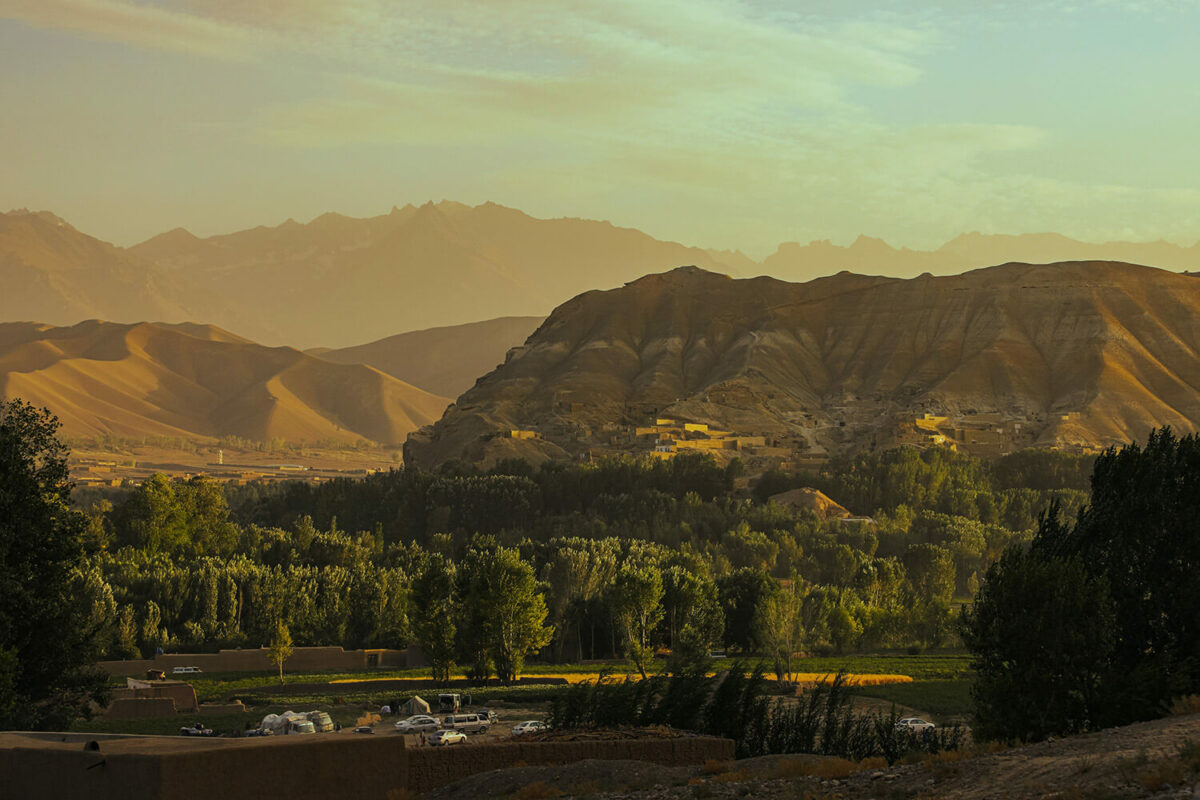Danna Harman didn’t have any tools or resources, but she knew she had to do something to help the Afghan girls who reached out to her.
Afghan Women: ‘We Are Not Fragile’
Bringing Visibility to Those the Taliban Seeks to Erase

Editor’s Note: We’re thrilled to announce this project has been nominated for Best Podcast in Public Service & Activism for the 28th Annual Webby Awards. Help us win the People’s Voice award by voting here thru April 18.
What do you think when you hear ‘Afghan Woman’? In this special podcast, The Story Exchange speaks to women who fled Afghanistan in the summer of 2021, as the U.S. withdrew its forces – and we also talk to women who remained. Our goal is to give Afghan women a platform to display their hope and defiance.
Listen to their stories here:
COLLEEN: This is The Story Exchange. I'm Colleen DeBaise.
SUE: And I'm Sue Williams.
COLLEEN: Today we're talking about Afghan women – women the world rarely gets to see in any nuanced way.
SUE: Some of them want to challenge how they're depicted in media.
MARWA: You probably were expecting a shy little girl who was dominated by men her whole life.
COLLEEN: That's Marwa Dashty, who now lives in Toronto.
SUE: She was forced to leave Afghanistan two years ago, when the Taliban took back control.
MARWA: Afghan women are not fragile. We've been fighting for centuries now for our rights.
COLLEEN: We'll bring you Marwa's story, plus that of several other Afghan women, including Shakiba Teimori, a former contestant on a TV show called Afghan Idol, whose music we're listening to right now.
SUE: Our reporter Kate Brennan –
KATE: Hey there.
SUE: – joined us to talk with these Afghan women now living in places like upstate New York and Calgary, as well as some who are still in Afghanistan.
KATE: I spoke with a former teacher, who actually chose to stay behind in Herat.
MUNIREH: I refuse to go. I am the only lady of my family here.
COLLEEN: While the situation continues to get even worse for girls and women. Here's CNN.
CNN ANCHOR: The Taliban this week banned all female students from receiving college educations, a devastating move…
SUE: These women want people to know there are still moments of hope in all the fear, and glimmers of defiance in the midst of brutal Taliban oppression.
COLLEEN: Let's start with how things were in Afghanistan, not that long ago. And, we also want to share how some of these women got out.
SUE: When we heard this incredible story earlier this year, we knew we had to make a podcast … although truthfully, we didn't know where it would take us.
COLLEEN: We met someone named Danna Harman.
DANNA: I've been a journalist my whole life.
SUE: She splits her time between Tel Aviv, London and New York.
COLLEEN: A few years back –
DANA: I think six, seven years ago.
COLLEEN: – she got a call from the New York Times.
DANNA: It was a dream assignment.
COLLEEN: The job was to cover Afghanistan’s first-ever all-girls robotics team …
DANNA: … as they went and competed in all these robotics competitions around. It was fun.
COLLEEN: The team got a lot of attention, especially when they arrived in Washington, DC in 2017 – here's NBC news.
NBC NEWS: Six Afghan girls, all-teenagers, competing with teams from 157 countries in the first international robotics competition.
SUE: Danna really got to know the young women. She kept in touch with them over the years
DANNA: I really loved a lot of them. I'm always over-involved, as my mother would say.
SUE: And then, in 2021, President Joe Biden declared …
JOE BIDEN: Our military mission in Afghanistan will conclude on August 31st.
COLLEEN: As the U.S. withdrew, ending 20 years of military presence, the Taliban began conquering the country at a rapid pace … and by mid-August, had swept into Kabul.
SUE: And that's when Danna got involved in a rescue effort so dramatic that it literally may be turned into a Hollywood movie.
COLLEEN: Yes. So … as the Taliban approached, Danna's phone began blowing up with text messages.
DANNA: I was on holiday in Venice.
COLLEEN: The young women – the former robotics team all-stars, who had shown off their talents for the whole world to see …
SUE: … who had become a symbol of a new Afghanistan where girls and women were educated …
DANNA: They were basically panicked, and in their houses, and writing to anyone they'd ever met in their entire life or hadn't met. “Hey, help me. We need to get out of here.”
COLLEEN: Danna began working the phones, reaching out to other journalists, ex-service people, lawyers – on WhatsApp and then encrypted apps, like Signal and Telegram.
DANNA: People started forming groups "Has anyone heard? Does anyone know? Is anyone getting into the airport?" We didn't know what we were doing either. We were like total novices, and we were just trying to help whoever we could.
COLLEEN: All of this is happening as Kabul goes from relative calm to scenes of utter chaos, especially at the Kabul airport – here's Inside Edition.
INSIDE EDITION: “Can't believe my eyes,” says the man who shot this video, of people clinging to an American cargo jet as it takes off.
COLLEEN: One of Danna's contacts …
DANNA: … brought in this guy, Yotam, who is the CEO of an organization called IsraAID.
COLLEEN: It's a big Israeli disaster-relief organization, headed by Yotam Polizer, which could help supply financing and connections.
SUE: And they were going to need a lot of them, especially as the airport became overrun and inaccessible.
DANNA: America did such a bad job in their evacuation, and it was chaotic, and so rushed, and no one knew what was going on.
COLLEEN: They raced to get the robotics girls out of the country, any way they could.
DANNA: The members of our team were around the globe. You would wake up after sleeping for four hours and you have, I'm not kidding, like 600 messages … what was happening with the passports, and what was happening with the visas and what was happening with the transportation.
COLLEEN: They managed, against the odds, to get a bus and they got the girls on it, along with a few others, like members of a female cycling team.
DANNA: Then there's the pop star and the judge --
SUE: IsraAid used connections to hastily print passports and secure safe passage, through Taliban checkpoints.
DANNA: I was texting to them as they were taking the bus through Afghanistan to the border of Tajikistan. It was really stressful.
COLLEEN: And when they finally got through the Taliban checkpoints and made it across the border –
DANNA: I was waiting for them. They were in our first group of women that we helped out. That group, that was 42 people. Then the second group, which was like 125 or so people, came out.
COLLEEN: One of the lucky ones was Rodaba Noori, who actually almost missed the bus.
RODABA: And then as I just got out of the taxi, I saw that the bus was moving.
SUE: She is one of the many Afghan women we'll hear from after a brief break.
*Commercial Break*
COLLEEN: Welcome back. We're talking about Afghan women, starting with the members of the robotics team, who even in pre-Taliban times had already led bold public lives.
SUE: So they were fearful of retaliation when the Taliban seized control.
COLLEEN: Danna Harmon managed to get them and others into Tajikistan, where they could stay for a very short window of time …
SUE: … and then into Abu Dhabi.
DANNA: They stayed in Abu Dhabi for basically a year until we worked on their cases and then they got out to Canada. Although, Rodaba is in college in America.
COLLEEN: Our reporter Kate Brennan recently went to visit Rodaba, one of the former members of the robotics team.
KATE (from broll): All right, I am getting in the car and I am driving up to Bard College, it's about 2.5 hours away and I'm going to meet up with Rodaba – and I'm really looking forward to hearing everything she has to say.
COLLEEN: So Bard is outside of New York City.
KATE: Yes – it's right next to the Hudson River and the Catskills. It's pretty and quiet – and probably couldn't feel more different than the pandemonium Rodaba left behind in 2021. Rodaba rode her bike over to meet me, wearing a black shirt and pants, and her long hair down.
KATE (from interview): I appreciate you making time for me.
RODABA (from interview): I'm so sorry that I couldn't like, you know, respond to the emails.
KATE: Her first year at Bard….
RODABA: I took principle of economics, I took dance class, chemistry class, mathematics class …
KATE: That also, could not be more different than Afghanistan, where young women are now barred from school after the 6th grade. Rodaba plans to continue the work she was doing before she fled…
Kate (FROM AUDIO): And you’re a computer science major?
RODABA: I am.
KATE: While she took many classes….
RODABA: The one thing I was really enjoying was computer science, because I was working this robotics team for almost three years. And then this one really inspired me, so I'm gonna go ahead with computer science.
KATE: She's been really game to immerse herself in the college experience and try new things – it's a freedom she didn't have at Herat University, where she had been studying.
RODABA: I think it's more fun being a college student in the United States. One of the ideas of being a college student is not just about always studying, it's that you have to take care of yourself, have to be away from the family finding friends, enjoying the events here.
KATE: For example, she learned how to swim. Growing up in socially conservative Afghanistan, swimming is not a common sport for women. Although, her first time in the Bard pool didn't go so well. She tells me nearly drowned
RODABA: And when I was like sinking and I was thinking God, what if on social media, they say that this girl has died because of not knowing how to swim and then people will make fun of you. The Taliban didn't kill her – she went to the United States and she's killed in the water.
COLLEEN: I like Rodaba's sense of humor – which honestly, is nice to see considering everything she's been through.
KATE: Exactly.
SUE: So … take us back a bit. Why did Rodaba feel the need to evacuate?
KATE: One day, back when she was competing on the robotics team, her local shopkeeper had warned her and her mother that two men had come in….
RODABA: They asked, we have heard that there is a girl from the robotics team who is living here. Could you please show us the home? And then that guy said, Oh no, I don't think that there's a girl living here from the team.
KATE: And when her neighbors learned she was on the robotics team, they were angry – they didn’t think Rodaba should have been allowed to travel without a male chaperone.
RODABA: They were shouting out on my mom that, Oh, you're not Muslim. And they were also shouting out to my father and my brother you guys are not Muslim. They had these dark ideas and opinions.
KATE: So when the Taliban came back into power, she felt she had to leave. It took her nine days of jumping from one bus to another, sleeping on the street one night, trying to find food….
RODABA: I only had my backpack. Maybe two t-shirts for me.
KATE: She remembers when she finally got on the IsraAid bus, after her taxi navigated the crowded streets ….
RODABA: I just sat in the bus for a few minutes because I was shocked and didn’t believe that I really caught the bus.
KATE: When that bus crossed the river, out of the country…..she remembers looking back, as the sun was setting, watching Afghanistan get smaller and smaller.
RODABA: And I told myself, look, this is the last time you're looking to your country.
KATE: It’s been almost two years since she crossed that border, and things are better now. Rodaba loves how peaceful it is at Bard – she showed me one of her favorite spots. Set back at the end of a gravelly road, past the farm where students grow fresh produce, is an historic mansion. She and her friends like to have picnics on the lawn there.
RODABA: I bring my tea here with my friends. We play music.
KATE: She’s grateful to have this new life in the U.S….she goes to class and can walk around by herself – both things that Afghan women can no longer do. And while we’ve all heard the cliché about leaving and never looking back, Rodaba does still look back – often.
RODABA: I still have like that connection to Afghanistan and the time I was there. And I know I'm in another country, but still I miss Afghanistan, I miss everything about Afghanistan. And I hope that one day, everything is just okay, as it was in the past. And I can go back home.
KATE: She feels for the women who are still in Afghanistan.
RODABA: I really appreciate their strength that they are really dealing with that stuff. I couldn't really do that, I couldn't really survive if I were there, but they are amazing.
SUE: When the US pulled out of Afghanistan in 2021, 20 years of gains were erased in a matter of days.
COLLEEN: Some are calling it "gender apartheid." Here's UN official Richard Bennet.
BENNET: The Taliban's intentional and calculated policy is to repudiate the human rights of women and girls and to erase them from public life.
KATE: I spoke with a few of these women who are still in Afghanistan, and one of them, a 26-year-old woman named Munireh, actually had a chance to flee – but chose to stay behind. I spoke with her over Zoom, but she kept her camera off.
MUNIREH: My father sent other ladies of my family to Iran, but I didn't want to go there because I had to be here. I was a teacher here. I used to teach. I refuse to go to Iran. I am the only lady of my family here.
KATE: Munireh is based in Herat City – one of the first places taken over by the Taliban. When it happened, she said no one could believe it. There had been rumors, but no one thought they would actually come. Then one day, she heard all the government offices had closed – and that’s when she knew.
MUNIREH: I couldn't even cry for one month, because I was shocked. And it was very strange for me.
KATE: She said it gets lonely, as she works from home by herself. But she pushes back against restrictions whenever she can. Once, she told her father she was going to a friend’s home, but really, she went to a protest. When I asked if she was afraid of retaliation from the Taliban, she said there was one thing she was more afraid of.
MUNIREH: I'm more afraid of the next decision that they make for us. For example, at first, when Taliban came, they didn't say anything to girls. But then they say No, women should not go to school. After that, they said, women shouldn't go to the university. I believe that tomorrow they will say a woman should not come out of home or anything, anything is possible.
KATE: And actually, since we spoke, the Taliban has made another decision – here's the BBC.
BBC: The Taliban have ordered hair and beauty salons to close within a month. The ruling is yet another blow for women's freedoms which have been dramatically limited…
COLLEEN: A lot of us in the U.S. have this basic understanding of what’s happening in Afghanistan. But I think it’s safe to say that most of us have never spoken to people living under Taliban rule. What was the most surprising thing you learned from Munireh?
KATE: That a small portion of the Afghan population is actually in favor of the Taliban. Some people support the Taliban because its values and religious beliefs align with their own, but others support it for more utilitarian reasons. For example, when the previous government was in place, Munireh said it would take many weeks to process forms in government offices.
MUNIREH: Now, they are arranged more. It takes less time.
KATE: She also said day-to-day civilian crime has been reduced due to extra security measures. But don’t get the wrong idea – she maintained that these changes are trivial if women are not treated as equals to men.
MUNIREH: Taliban provides security, Taliban provides many improvements here, but if I'm not free, I don't like it.
COLLEEN: That’s interesting to hear because those details teach us more about why the Taliban holds this power.
KATE: Munireh – and other women we interviewed – also had a lot of critiques about the way media outlets portray Afghanistan. She even used that notorious saying we hear so frequently in the U.S.
MUNIREH: Fake news.
KATE: Specifically, she was fed up with the narrative she has heard that no Afghan people want to seriously challenge the Taliban’s laws
MUNIREH: For example, I'm in a telegram group, where some of the scholars have gathered together to, for example, to manage the protests...but they do not know how to gather all the girls.
KATE: She wishes more people were as vocal as she is.
MUNIREH: One thing I don't like about Afghan people is they accept very soon.
KATE: Although she knows what’s holding many people back.
MUNIREH: People are tired. Most of them just want a roof over their head and bread to eat and that is the reality. And I understand most of the people, if they are, if they accept, if they are afraid, I understand them. I am hopeful about a revolution. I always pray that people of Afghanistan create a revolution. But I say that it takes time.
KATE: At one point, I noticed a shift in my conversation with Munireh. At the beginning, she had told me…
MUNIREH: Everyone is hopeless. People are only thinking about a way to go out.
KATE: But I asked her at the end of our conversation if staying behind by choice was a small act of hope on her part. She paused for a moment and contemplated.
MUNIREH: Hope is strange, is a very strange thing. In the worst situation, it does not go completely. It does not disappear completely.
KATE: Today, with women still barred from schools and work after nearly two years, it's difficult to stay optimistic. Many women are suffering depression and anxiety, not knowing what the future will bring. But for Munireh, hope is a conscious choice she makes out of the love she has for Afghanistan.
MUNIREH: It is not important how, how much it is painful living here. I can't stop loving it.
COLLEEN: That love for Afghanistan is something we heard from so many of the women we talked to.
KATE: Even the women who fled.
SUE: For those women, their stories become like so many other immigrants' stories – particularly anyone who's been forced to leave their homeland because of violence or poverty.
KATE: When you leave your country, you leave your culture, your language, your family, all the things that are important to you….
COLLEEN: When we come back, we'll talk to another young refugee who is building a new life for herself in Canada, who wants to change what we think when we hear the phrase “Afghan woman.”
SUE: We'll be right back.
*Commercial Break*
COLLEEN: Welcome back. We've been sharing the stories of Afghan women, whose lives have been turned upside down since the Taliban took control of the country in 2021. Women who the world rarely gets to see, or hear from, in any sort of in-depth way.
SUE: If you do a Google image search of "Afghan women," you'll likely be served an image of a woman behind a burqa, quite literally invisible to the outside world.
MARWA: Afghan women are not fragile. We've been fighting for centuries now for our rights.
COLLEEN: That's Marwa Dashty, a 20-year-old from Kabul, who grew up spending time on her grandfather's farm in the Panjshir valley.
MARWA: It has beautiful mountains, a big river.
COLLEEN: I first met Marwa a few months ago, over a Zoom call.
MARWA: Thank you so much for giving me the opportunity to speak up.
COLLEEN: Oh, of course.
COLLEEN: Marwa's father, Fahim Dashty, was a prominent journalist – and a vocal critic of the Taliban.
MARWA: Anyone probably in Afghanistan right now knows who my dad is.
COLLEEN: After the Taliban seized control, Marwa and her family – her parents and her little brother – were able to work connections to get visas for Pakistan. But her dad decided to stay.
MARWA: He actually sat me down and told me that. "You're my daughter, and I love you. You just got to know that this is probably our last goodbye. Just know that I'm doing this because I would not survive in any other country knowing that my people are suffering." Those were the exact words he told me.
COLLEEN: He joined the National Resistance Front, led by Ahmad Massoud.
MARWA: Who are actually currently still actively fighting against the Taliban.
COLLEEN: And within days, in early September 2021 …
MARWA: We received news through social media that he had been captured and then killed after a few hours, which was heartbreak.
COLLEEN: Here's OneIndia News.
ANCHOR: According to reports yesterday Fahim Dashty the spokesperson of Ahamad Masood was killed during fighting with the Taliban in Panchir. The Facebook page of the National Resistance Front of Afghanistan also put out a statement…
SUE: How did Marwa get out of Afghanistan?
COLLEEN: So she and her mom and her little brother hired a car and a driver, who pretended to be a male relative – and basically sweated through every Taliban checkpoint.
SUE: But they got out.
COLLEEN: Yes, to Pakistan – although they didn't feel safe there either, because of political reasons – but the international group Vital Voices –
MARWA: It's a big organization co-founded by, I think, Hillary Clinton.
COLLEEN: Hillary Clinton and Madeleine Albright.
MARWA: Very quickly, in a matter of, I think, five days in total, they were able to move us to Albania, where more than 2,000 other refugees were staying. We spent about eight months in Albania, which is where I met Danna. After that, Vital Voices helped us start a case to emigrate to Canada.
COLLEEN: I decided to pay Marwa a visit there. I drove there from my hometown, in upstate New York, clearing customs near Niagara Falls.
COLLEEN (FROM BROLL): Hi there.
BORDER GUY: Citizenship?
COLLEEN: U.S.
BORDER GUY: Where are you headed?
COLLEEN: Toronto, just for the day.
COLLEEN: I wasn't sure what to expect, meeting Marwa and her family. I decided to wear something modest – a black dress – just in case they were super conservative. She lives in Mississauga, a very suburban area with nice homes. People were walking dogs, a guy was just about to turn his leafblower on. Her little brother opened the door.
COLLEEN (FROM BROLL): I’m looking for Marwa?
BROTHER (FROM BROLL): Yes, this is here.
COLLEEN (FROM BROLL): Should I take my shoes off?
COLLEEN: And then Marwa bounded over. And … she looks like a typical teenager, wearing her dark hair long and a blue-and-white striped shirt, with jeans and sneakers. She has a bright smile, made even brighter by the braces that are now on her teeth. We almost immediately sit down to a homemade lunch, made by her mom, Sayara – who didn't speak much English, but I think she understood a lot.
MARWA (FROM BROLL): So this is the rice and this is called “porma.” So it's basically a sauce of like, tomatoes and onion and garlic…
COLLEEN: By the way, the sounds you might hear in the background is her brother playing a video game – typical 13-year-old.
MARWA (FROM BROLL): It's traditional for the older people to start out first.
COLLEEN (FROM BROLL): OK (laughter).
COLLEEN: And Marwa's mom, who's wearing a cute t-shirt with a cat on it, apparently didn't think I took enough food, so she piled more on my plate. (Mother speaking in Persian)
MARWA (FROM BROLL): That's just us. Whenever a guest comes in, you just have to eat. They force us to eat, that's what they do!
COLLEEN: Whether they're hungry or not.
MARWA: That's just our tradition. (laughter)
COLLEEN: I'm surprised at how normal this all feels – the only thing that hints at the pain of their past is a giant photo of Marwa's Dad, printed on a poster and propped up at the end of the table, almost like he's with us. Marwa tells me a lot about her childhood …
MARWA: Oh, my grandparents' farm, what I would give to go back to that farm …
COLLEEN: The farm has animals, and vegetables – it's next to …
MARWA: The beautiful, massive river, that sound is so calming. The garden, there's more than a thousand flowers.
SUE: How does Marwa speak English so well?
COLLEEN: You know, she gets this question a lot – and it actually irks her.
MARWA: The fact that that's such a surprise comes from the narrative of the media, because you probably were expecting a shy little girl who was dominated by men her whole life!
COLLEEN: She added that she also gets asked about headscarves and burqas.
MARWA: When I tell people I didn't wear a scarf, they're shocked. They think that I probably wore a burqa and I was stoned if I didn't wear a burqa, which is crazy to me.
COLLEEN: Marwa learned English at school, reading books like Harry Potter, and of course, watching American TV shows.
MARWA: Friends, How I Met Your Mother, the famous shows that I -- I love Friends. I've watched it more than a million times. I know every single line. Quiz me. I'm just waiting for someone to quiz me.
COLLEEN (FROM BROLL): Who's your favorite character?
MARWA: Phoebe.
COLLEEN (FROM BROLL): Phoebe? (laughs)
MARWA: She's just so weird and I love her.
COLLEEN: Anyhow, the point of all this is that Marwa is fed up with how the media often portrays Afghan women as victims. It just doesn't reflect the two decades she spent in Afghanistan.
MARWA: To hide this whole side of empowerment, of growth, of freedom, and to just show the dominance, women who have nothing and no power, it's just not fair to us, to everyone.
COLLEEN: And it also doesn't quite reflect what's happening now.
COLLEEN (FROM BROLL): Is the media getting anything right with the portrayal of what's happening now for women who are still in Afghanistan?
MARWA: I'd say yes and no. They do get right to a point where there's no education and whatever, whatever, but they don't really talk about, let's say, all the online schools that the community has built within themselves. I know that girls started online schools with Telegram and with no resources and nothing else. They don't show that resilience. They don't show that they're still fighting.
COLLEEN: Later that day, Marwa and I pop over to the Middle Eastern restaurant where she's been working, to earn money – Canada took care of her family for about a year, under a special resettlement program – but now they're earning their own way.
MARWA (FROM BROLL): We can probably go inside – there's a very good dessert – you're going to love it.
COLLEEN: It's fun to see Marwa with her restaurant friends – she has a bubbly personality and it's clear that they all love her. We sit toward the back of the restaurant, where there's a lot of windows and people smoking hookahs. We eat kunafeh – basically cheese pastry with a sweet sauce. I ask Marwa about her parents. She explained to me their names, Fahim and Sayara.
MARWA: Sayara means “planet.”
COLLEEN (FROM BROLL): Planet?
MARWA: It means “planet” in our language, and Fahim means “the knowledgeable one,” which fits my dad perfectly – and then my dad always thought people named "Marwa" are smart. I don't know if he got what he wanted, but yeah.
COLLEEN: While we're at the restaurant, Marwa tells me about the day she learned he had died, along with her uncle, who had also stayed to fight the Taliban. She was staying at a house in Islamabad. She heard screaming – it was her mom and her aunt – who both fell to the ground. This is a short clip of her mom, in an interview with the TV news channel Afghan International. And she's talking about the day her husband was "martyred" – a word that Marwa used too. She explained to me in her culture, a martyr continues to be present.
SUE: As in, not really dead.
COLLEEN: That's right. And it explained to me, at least in a cultural sense, how Marwa herself could be so upbeat and optimistic, even in such a difficult time.
MARWA: My dad always had this phrase that he always used … It's an Arabic word and it means, “It's all upon God.” I'm going to give you the wider definition because I don't know how else to explain it. It's just leaving yourself to the universe or to God or to whatever you believe in, and he's going to do what's best for you. We've been through the worst. There's nothing that can get worse. There's only good things ahead.
SUE: It's pretty amazing that she can feel that optimism.
COLLEEN: I know. And we certainly spoke to other Afghan women, who didn't feel that sense of optimism, necessarily. I spoke to a female judge – I can't say her name, for safety reasons – but she is also in Canada. She is one of a couple hundred female judges who have been evacuated, in her case, through Danna's efforts but also a big undertaking by the International Association of Women Judges. When the Taliban took over, women in positions of power – judges, lawyers, journalists, police officers – were big targets for assassination.
SUE: What did the judge you spoke with say, about the future?
COLLEEN: She said that it's "very, very difficult to have hope at the moment" and that women are basically living under house arrest. And she was particularly concerned for women in rural areas, who don't have access to the internet and who can do little in the way of educating themselves.
SUE: Did any of the Afghan women talk about the United States or the lack of attention from the international community in general?
COLLEEN: Yes. For all of her optimism, Marwa had something to say about that. I think it can be a bit surreal for her, living so far from home.
MARWA: It's just not fair that in this part of the world, we're thinking about going through Mars, and then in that part of the world, girls aren't able to go to higher education.
COLLEEN: She's hopeful that the international community will get more involved.
MARWA: I'm just hoping that the world is going to wake up and give us those resources. We don't want them to fight for us. We just want some resources to fight for ourselves. That's all we want.
COLLEEN: Before we get to the end of this podcast, we wanted to circle back to a theme of hope that's come up a few times.
SUE: To the outside world, certainly, there's been very little reason to feel hopeful about the situation in Afghanistan.
COLLEEN: The Brookings Institution, the big think-tank, released a report in 2023, noting that anti-Taliban resistance from within Afghanistan has caused only "minor irritation."
KATE: The report also called the humanitarian situation "excruciating," with 6 million on the brink of famine. Some say that only fractures within the Taliban itself could change its hold on power.
SUE: Dictatorships sometimes do fall.
COLLEEN: And while it may be easy to turn away – and many in the world have – spending time with some of these women, who love their country so dearly despite everything they've lost, truly makes you see the situation in a different light.
DANNA: Oftentimes, they say to me, all my new Afghan friends, "Someday we'll go back to Afghanistan and we'll show you around when the Taliban are no longer there."
KATE: That's Danna Harmen again, who's helped evacuate so many of these women, and seen so much pain and chaos and injustice.
DANNA: I found again and again in the language, especially a lot of times when I'm typing and texting with all these Afghans, there is an optimism and poetry of looking at life and at things which I think keeps them afloat somehow. They just wrote me some birthday notes the other day. They say, "We would love to paint your life in colors." When my dad died, they said, "Let us carry your pain for you a little." Really beautifully said and sort of delicate. It puts my own life into perspective as well.
MUSIC: Shakiba Teimori’s song “Banooy Kabul.”
KATE: Speaking of that optimism and poetry, the lyrics you just heard in the song "Banooy Kabul" translate to “I’m active as sea’s water, shiny as night’s moon.” They come from Afghan pop star Shakiba Teimori. She is another one of the women that Danna helped evacuate from Afghanistan on the IsraAid bus.
SUE: Why did she feel she had to escape?
KATE: Shakiba had appeared on “Afghan Star,” a reality TV show that searched for Afghanistan's top singers. It's of course not on anymore, as the Taliban has banned music – but back in 2020 Shakiba was a contestant. She didn't cover her long hair, which could be seen as provocative. Here's a clip. She's wearing a traditional dress but her hair is cascading down past her waist.
SUE: So when the Taliban came, I guess that was enough reason for her to flee.
KATE: That's right. She now lives in Calgary, where she feels safe to wear her hair long – but the change in lifestyle has been a big challenge.
SHAKIBA: Calgary is a really small city, like the population. There are not so many Afghans and I don't know so many people.
SUE: Does Shakiba still sing?
KATE: She wants to, but she doesn’t have much of a fanbase here. There was something she said that still sticks with me. When I asked her what she misses most, she said …
SHAKIBA: The most, I think, I miss myself.
SUE: She misses herself.
KATE: Powerful, right? And I think that summarizes how lots of Afghan women who fled are feeling right now. By leaving home, many of them feel that they left parts of themselves behind as well.
COLLEEN: There was a recent documentary about America and the Taliban on Frontline, the PBS series, and at the very end, a former U.S. military officer says, "It was not worth it."
SUE: He's referring to the 20 years and billions of dollars spent, and countless lives lost, during the period when the Taliban were held at bay and progress – especially for women – was made in Afghanistan.
COLLEEN: Here's a short clip.
LT COL JASON DEMPSEY: We kicked out the Taliban originally, we ran Al Queda out – but then in wanting everything we got close to nothing.
KATE: Was it nothing, though?
SUE: Here at The Story Exchange, we often say: You can't be what you can't see.
COLLEEN: For the young women who came of age over the past two decades, they got at least a glimpse of what is possible. Here's Marwa again.
MARWA: I think that the women in Afghanistan, although they probably don't see it right now, we all have this spirit in us because, again, we saw the progress with our own eyes. We saw that it was getting better. I feel like all of us inside, there's just that little part inside of us that does believe that the Taliban are not going to stay forever. When they go away, that we all know what to do. We proved ourselves, we made that progress, and we can do it again. I feel like even though it's probably right now, especially for the woman who are inside, it's very deep down, but there's still that ray of sunshine, that ray of hope.
COLLEEN: We thank all the women for sharing their stories
SUE: And we thank you for listening.
OUTRO: This has been a special project from The Story Exchange, a nonprofit media company dedicated to elevating women's voices. If you liked this podcast, please share on social media or post a review on iTunes. It helps other people find the show. And visit our website at TheStoryExchange.org, where you’ll find news, videos and tips for entrepreneurial women. And we’d love to hear from you! Drop us a line at [email protected] — or find us on Facebook. I'm Colleen DeBaise. This episode was reported by myself and Kate Brennan. Sound editing provided by Nusha Balyan. Our production coordinator is Noël Flego. Our mixer is Pat Donohue at String & Can. Executive producers are Sue Williams and Victoria Wang. Our thanks to Shekiba Teimoori for allowing us to use “Banooy Kabul” throughout this podcast. You can find more of her music at her Youtube channel, Shekibamusic.
Nearly 4,000 miles away, an Israeli-American journalist named Danna Harman – who had traveled to Afghanistan four years prior to report on an all-girls robotics team – was on holiday in Venice. Her phone was blowing up with messages from Afghan women she knew, asking for help. So, she started making some calls. That was just the beginning of an escape operation that helped nearly 200 Afghans relocate – first to Tajikistan, then to a refugee camp in Abu Dhabi, then finally to Canada.
With Harman’s help, we got in touch with some women who fled Afghanistan – as well as some women who are still there. And we want to share their stories with you.
What do you think of when you hear “Afghan woman”?
“You probably were expecting a shy little girl who was dominated by men her whole life.”
-Marwa Dashty
For many, stereotypical images of women in burqas come to mind. We might picture Afghan women being oppressed by men, subservient, staying at home, speaking when spoken to. Hidden from the public eye.
Every now and then, maybe we’ll see a news feature about an Afghan “genius girl” who excels in sports or in STEM. Good for her, we think. And we treat her as an exception to the stereotype, rather than an example of what all Afghan women are capable of.
This way of thinking can be traced to the endless stream of news stories telling us about the ways in which Afghan women are oppressed, which too often eclipses their identities – their sense of humor, quiet moments of rebellion and their poetic way of speaking.
Our goal with this project is to give Afghan women – those who fled and those who stayed behind – a platform for visibility at a time when the Taliban seeks to erase them from public life. We hope to paint a fuller picture than what’s typically seen. Yes, there is painful inequity and a collapse of rights and dreams. But there is still hope in all the fear, and glimmers of defiance in the midst of brutal oppression.
“So now, with 70,000 to 80,000 Afghans coming to the U.S., I’d recommend allowing them to join the community in your city in your neighborhood.Talk to them, learn about their life and see how you can help them. Having one-on-one interactions is helpful. Open your eyes about who they were in their country and what they were doing, and rely on in-person, direct contact with people. That would help them a lot, rather than just the stories that the media tries to sell out.”
-Fereshteh Forough
The Women We Talked To
The Aspiring Journalist Following in the Footsteps of Her Father
Marwa Dashty’s father, a well-known journalist, was killed after the Taliban took over. Now, the 20-year-old wants to continue his legacy by becoming a journalist herself.
The Teacher Who Chose to Stay Behind
When Munireh’s father first received news of the Taliban takeover, he sent all the women in the family to Iran – but she refused to leave Afghanistan.
The Pop Star Whose Fan Helped Her Get Out
After Shakiba Teimori showed her long, flowing hair on television, it was as if she were exiled. And then she fled for real.
The Judge Who Escaped: ‘We Lost All of Our Achievement’
Since the Taliban’s return to power, women judges – who once dared to sentence men for their crimes – have been forced into hiding. We spoke to one whose identity we are protecting.
The Founder of Afghanistan’s First All-Girls Coding School
Fereshteh Forough opened Afghanistan’s first coding school for girls and women – but the Taliban’s ban on education prevents students from learning in-person.
The Mobile App Developer Secretly Working Online
Parima hides the fact that she works remotely, as many of her neighbors in Afghanistan don’t believe women should have jobs.
The College Student Getting a Fresh Start
Rodaba Noori is enjoying her new life at Bard College in upstate New York, but she still doesn’t consider it home.
